Features of ammonium nitrate and the rules for its introduction
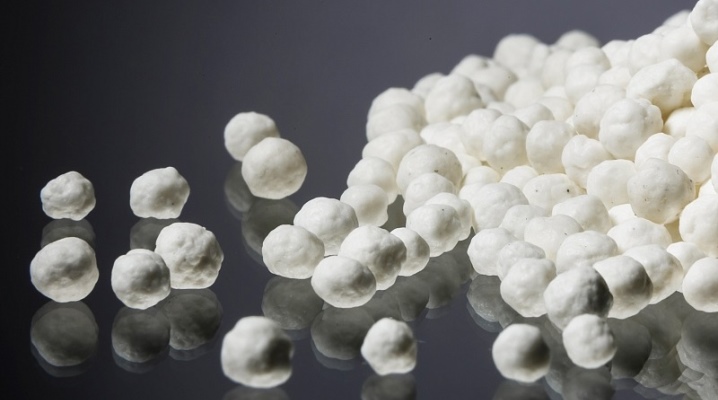
Almost every summer resident with experience knows what it is ammonium nitrate and what it looks like. You should know what benefits this substance brings, and what it is for.
What is it and what is it for?
This drug is proven to be highly effective. mineral nitrogen fertilizer of universal type... It is usually produced in granular form, the shade of the mixture is yellowish-white. Instant granules with sulfur in the composition. In another way, this fertilizer is called ammonium nitrate or ammonium nitrate. The percentage of ammonium nitrate is as follows:
- sulfur - up to 13%;
- ammonia - up to 52%;
- nitrogen - up to 35%.
Under natural conditions, nitrogen is a volatile substance, that is, it very quickly loses its beneficial properties. On average, after opening the package, the substance should be used within 14-20 days.
In horticulture, ammonium nitrate is used to:
- general soil mineralization;
- increasing crop yields (up to 50%);
- protecting plants from bacterial and fungal diseases;
- improving the process of photosynthesis;
- improving the taste of fruits;
- accelerating the growth of green mass by plants.
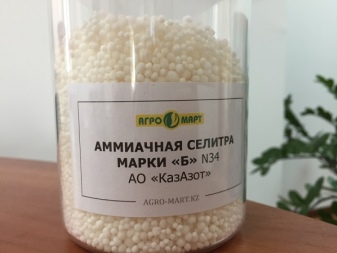
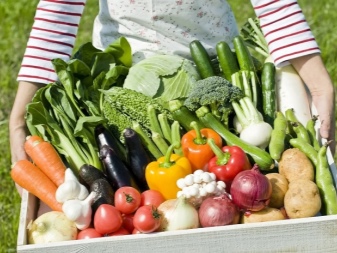
Fertilizer has a number of differences in composition, manufacturer and total concentration.
- Chilean saltpeter. Its composition is dominated by sodium, due to which the roots ripen faster.
- Magnesium saltpeter Is a great option to feed legumes.
- Simple ammonium nitratewhich is used in agriculture.
- Fertilizer of Norwegian production with the addition of calcium... It is successfully used if the root system is clearly decaying.
- Lime type. It combines calcium and magnesium oxides. The scope of use is depleted soil.
- The drug is brand "B". Usually packaged in small bags, they are fed with houseplants. Does not contain sulfur, it is pure nitrogen.
- Potassium nitrate. Improves the taste of fruits of various crops.
Ammonium nitrate is among the cheapest fertilizers on the market. This is a very affordable option for both the general gardener and the industrial scale. The specific properties of this fertilizer can be attributed to its undoubted advantages:
- is a good soil acidifier;
- dissolves in water without precipitation;
- includes 2 types of nitrogen: one acts quickly, the second - gradually;
- well absorbed regardless of soil temperature.
Also, do not forget about the disadvantages:
- if the soil is acidic, do not use saltpeter;
- in case of an overdose, burns the roots of plants;
- it is impossible to spray the leaves with fertilizer - this leads to their burns.
Note that this dressing is quite strong, it can both help and harm crops. If used incorrectly, you can simply burn the crop.

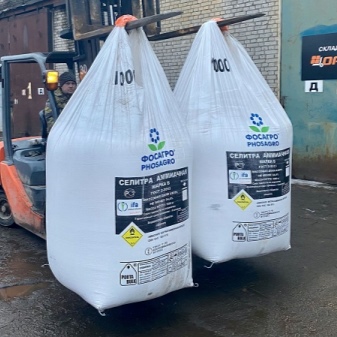
Application rates
The amount of nitrate applied depends on 2 main factors:
- on the type of culture;
- on the composition of the soil.
Mainly for maximum effect fertilizer is applied in the spring, since the abundance of precipitation in the fall will simply wash the saltpeter out of the soil. The duration of the drug is on average 2 weeks, and after 30 days, feeding can be repeated.
Top dressing from ammonium nitrate can be used both dry and as a solution. In early spring, the preparation can be used directly on the snow. After digging, the granules are poured into the ground, and the solution can be diluted for trees and shrubs. You can make a feeding solution by following the following instructions:
- keep in mind that 1 tablespoon contains 13 g of saltpeter;
- do not mix the product with other fertilizers;
- dissolve granules in warm water, fill them in small portions;
- if you need to feed shrubs, then the application rate is 20 g of the drug per 10-liter container with water;
- when fertilizing vegetables, use 10-12 g per 10 liters of water.
If we talk about the introduction of dry matter, then for vegetable crops the norm is 30-40 g per square meter of soil, for shrubs we add 10-15 g to each well.

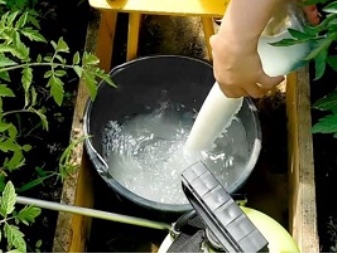
What can you feed?
For feeding young seedlings, ammonium nitrate is used extremely rarely, since it can simply burn the sprouts. Therefore, its use for seedlings should be accompanied by abundant watering. Note that it is better not to feed zucchini, pumpkin and squash with saltpeter, since these crops are prone to the accumulation of nitrates. But the use for berry bushes, lawns, indoor plants, various colors is only welcome.
Usually in the country and in the garden there is always something to fertilize. For example, roses loved by a huge number of gardeners. In this case, the algorithm of actions is as follows:
- at the beginning of May, we dilute one tablespoon of the drug in 10 liters of water;
- under each bush we bring about 6 liters of solution;
- after 3 weeks, we repeat the feeding to stimulate the development of buds;
- after the appearance of the first flowers, we do not add more saltpeter.
Concerning indoor plants, then fertilize them with ammonium nitrate to accelerate growth. One pinch of granules is diluted in a 1.5 liter watering can. Most often, such dressings are carried out in the spring, when the plants need nitrogen most of all and are actively growing. Spraying plants with a solution of nitrate is not recommended, since the flower can be simply burned.
Influence of feeding with ammonium nitrate on barley and winter wheat... Barley is a crop very responsive to feeding. During the tillering period, he most of all feels the need for nitrogen, which compensates for the introduction of ammonium nitrate. Winter wheat needs nutrients, and the whole complex. In particular, it is fed in early spring during flowering and during seed formation.
Usually the soil is fertilized with ammonium nitrate before sowing. Contribute at the rate of 30 kg per 1 hectare of soil. Nitrogen increases the yield of wheat, affects the height and density of wheat bushes. When working with fertilizer, it is worth remembering that it is explosive.
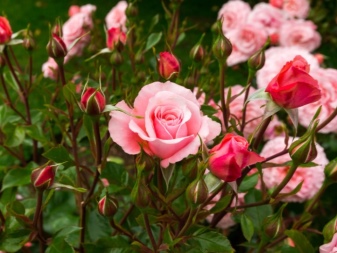
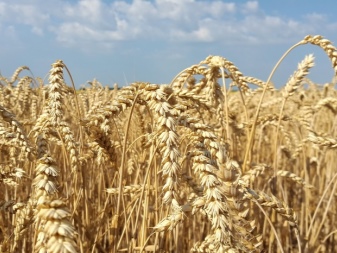
Other crops have their own peculiarities of applying fertilizer granules.
Tomatoes
For feeding tomatoes ammonium nitrate is added in combination with superphosphate and potassium salt. When tomatoes are planted in a permanent place, saltpeter is added at the rate of 1 tablespoon per planting hole. When the seedlings begin to bloom, 5 g of fertilizer is already applied for each square meter of soil. Saturation with nitrogen contributes to the growth of green mass in tomatoes and the strengthening of the stems.
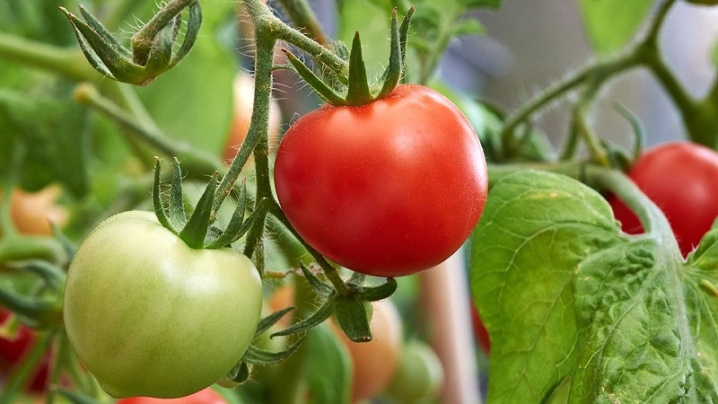
Cucumbers
Many experts inform gardeners that cucumbers accumulate nitrates very quickly. So, fertilizers should be applied with great care, not exceeding the recommended dosages... Ammonium nitrate is most often applied before planting cucumber seeds in the ground. You can simply sprinkle the pellets over the snow while it is actively melting. Water the cucumbers with a solution during the period of active growth of the lashes, before flowering. The application rate is 15-20 g of the drug per 10 liters of water.
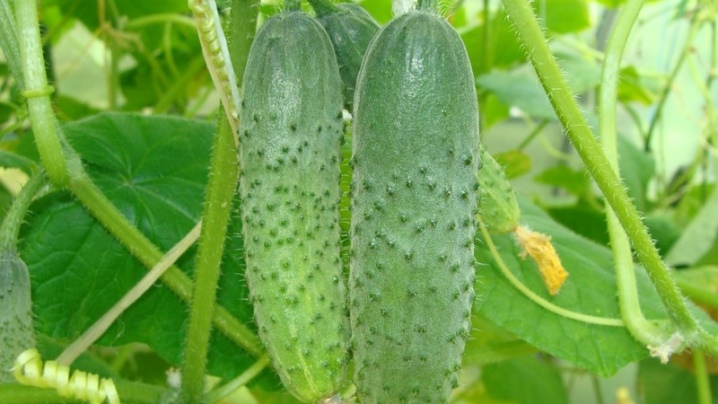
Strawberries
Initially, compost or humus is added to the strawberry beds. This is done before the berries are planted in a permanent place. In the first year after planting, nitrogen-containing fertilizers are not recommended for this crop. Their presence can provoke decay of bushes.
When the second season begins, in spring, 100 g of fertilizer is applied per 1 square meter of area.... In the aisles, you can make grooves no deeper than 1 cm, lay granules in them and water. You can also dilute the ammonium nitrate solution.Take 30 g of fertilizer, dilute in 1 liter of water and water each bush with this composition at the root.
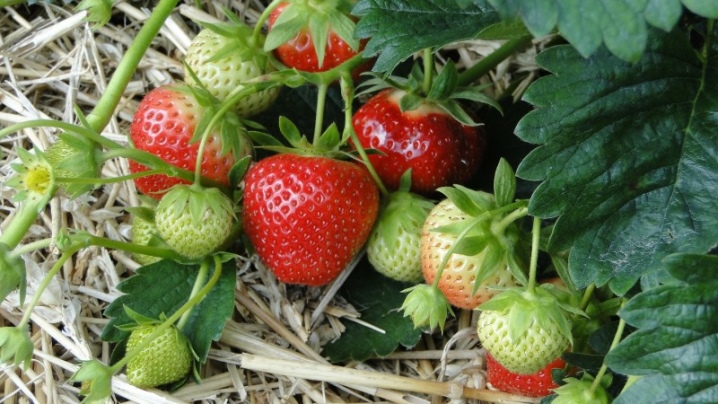
Potato
For annual feeding of potatoes, ammonium nitrate is the best option. The application rates are as follows:
- if the soil is poor, depleted - 20 g for each well with potatoes (dry);
- if the soil is in good condition - 10 g for each tuber.
Usually, potatoes do not absorb well the substances with which they are fed. That's why all vitamins should be applied directly to the wells. The lack of any substances in potatoes is expressed in a very specific way. On one plant, it can appear, and the bushes growing nearby will be completely healthy. Or several bushes are ill on different sides of the garden. In all plants, this can be seen when the lack of a particular substance becomes critical.
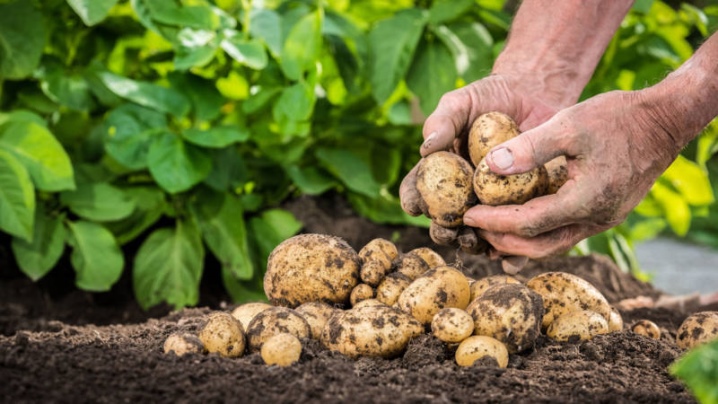
Garlic
For the first time, you can feed the garlic with ammonium nitrate both in spring and in autumn, it depends on the time of planting the culture... Dilute 30 g of nitrate per 10 l of water and add to the soil. Even after adding the solution, the garlic is watered abundantly. For the entire growing season, feeding is carried out 4 times. The latter is carried out a couple of weeks before harvest.
In a hot period, use only a solution, in a cool period, add granules.
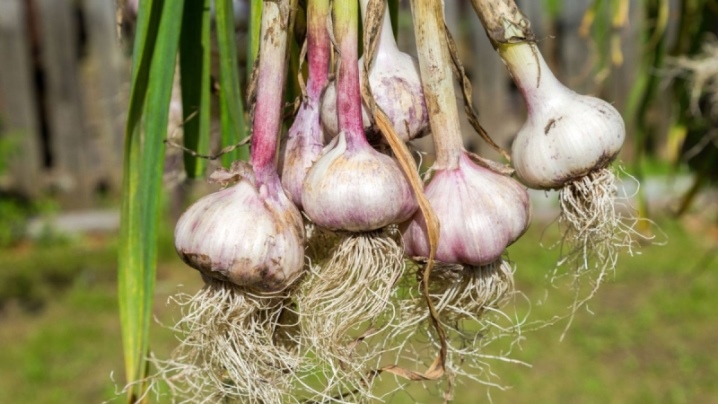
Onion
Watering onions with ammonium nitrate allows not only to improve its taste, but also to scare off pests. It is important that the onion assimilates nitrogen at a tremendous rate.... The sooner you start processing onions, the better the yield will be. But so that all the growth does not go into the feather, fertilization is stopped 1 decade after the emergence of shoots.
Gardeners carry out processing as follows: fully fertilize the soil before the cold weather sets in. In the spring, they feed the land with saltpeter only before planting onions. On the beds, grooves are made no more than 3 cm wide, granules are added, and after 20 minutes they are watered. This is how the saltpeter interacts with the soil and is better absorbed.
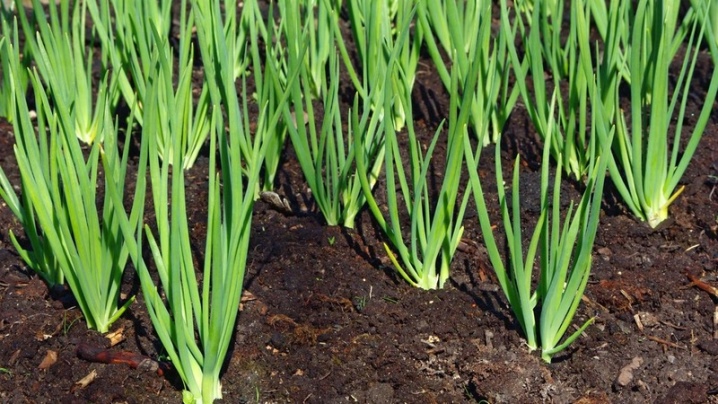
How to store fertilizer?
Any gardener should not be neglected correct storage conditions for fertilizers. Ammonium nitrate is a hazardous substance and should be stored in a dry and well ventilated room. Moreover, the air temperature will also have to be monitored, it should not exceed + 30 ° C. It is strictly forbidden to store saltpeter under a canopy or in the open air. If we talk about agricultural organizations, then the storage of nitrate is coordinated with the fire department. Objects and liquids that easily catch fire should not be kept nearby. Storage containers should be airtight and better signed.
As for the shelf life, manufacturers usually indicate 6 months, which fully complies with GOST. There are gardeners who are sure that nitrogen fertilization is harmful to human health.
Experts explain that harm to health can only be caused by excessive enthusiasm for top dressing, with the introduction of huge doses of fertilizer. With the correct, rational approach, nitrogen fertilizers do not cause any harm.
In the next video, you will learn about the differences between urea and ammonium nitrate.













The comment was sent successfully.